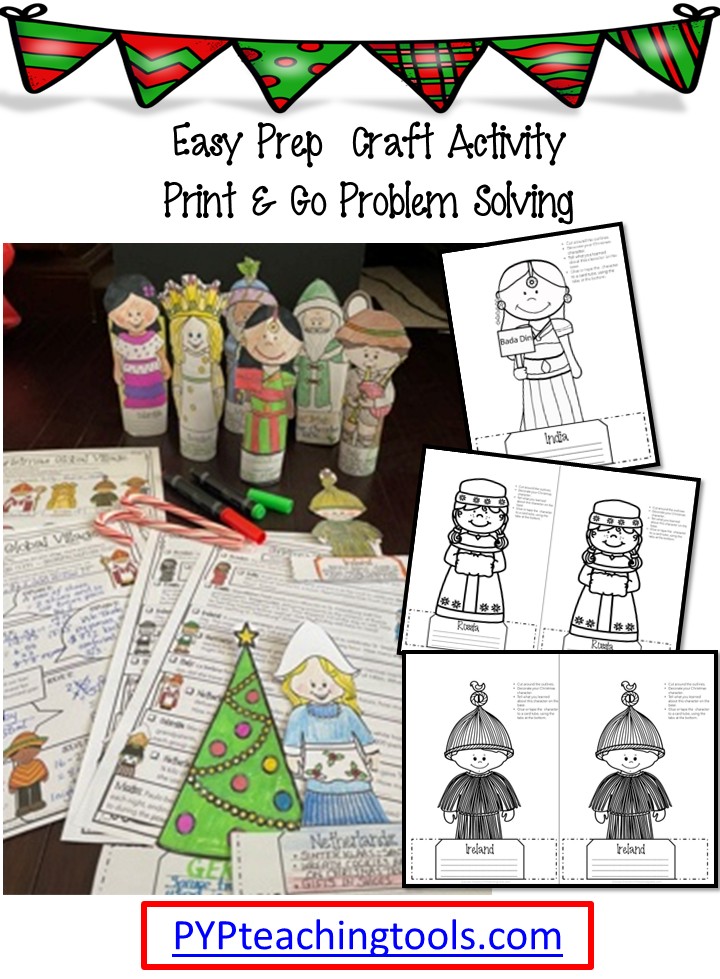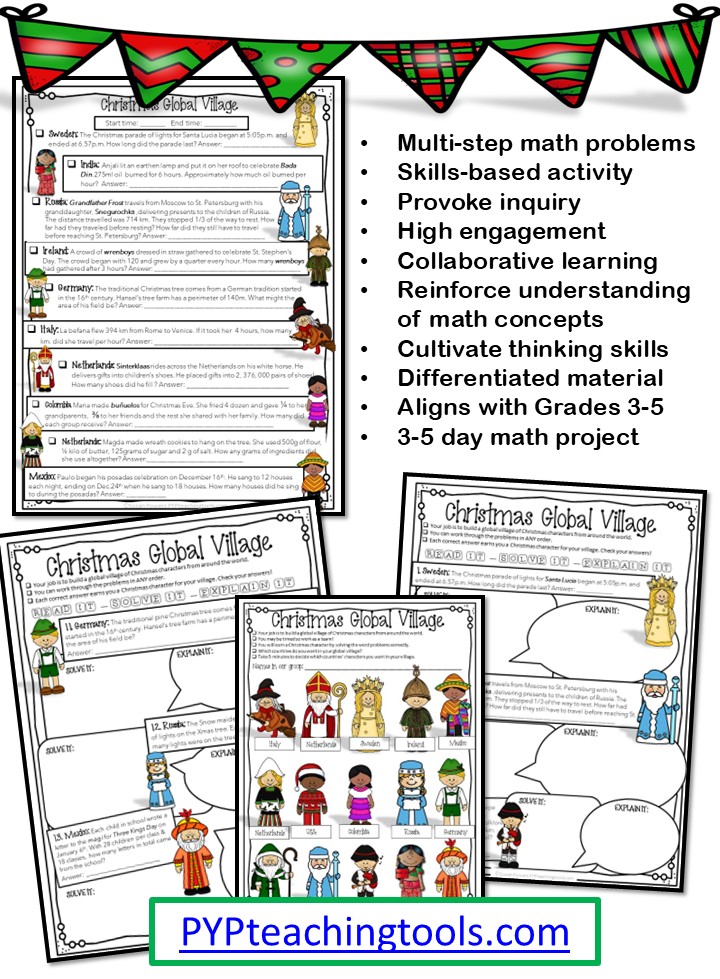The Global Christmas Village: A Project-Based Math Inquiry for Upper Elementary Students

Challenge your upper elementary students with this inquiry-based math project! The Global Christmas Village engages Grades 4–5 learners in real-world problem solving with number sense, measure and design thinking using festive, global themes.
Transform Math into a Real-World Inquiry
In my Grade 4/5 classroom, the Global Christmas Village Math Inquiry became a highlight of our pre-holiday weeks. What began as a set of differentiated problem-solving sheets evolved into a bustling global village of characters, traditions, and beautifully measured designs all imagined, calculated, and constructed by the students themselves.
This project turned abstract math concepts into something tangible. My students weren’t just solving word problems; they were earning their way into creating a global Christmas village filled with characters and celebrations from around the world.
What the Project Involves
The goal of the activity is to collaboratively create a global village of Christmas traditions, with characters from around the world.
Students solve math problems to “earn” new characters, then bring them to life by decorating and constructing them. Each completed figure becomes part of a growing global village — filled with creativity, collaboration, and plenty of mathematical thinking.
I told my students, “Every problem you solve adds one more citizen to your Christmas Village.” The motivation was instant.
Students explore multi-step word problems grounded in real-life scenarios:
How many meters of lights will each street need?
What’s the total area of the village square?
How can we design buildings within a specific budget?
They apply their knowledge of operations, measurement, and data handling but in a creative, hands-on context that feels authentic and joyful.
How the Project Works
You have two options for setup:
1️⃣ The Shorter, Timed Challenge
Use the one-sheet version for a fast-paced two-day challenge (about 60-minute periods).
2️⃣ The Read It, Solve It, Explain It Inquiry
For a deeper, collaborative inquiry, print the full set of problem sheets and let students choose where to begin.
The Read It, Solve It, Explain It strategy lies at the heart of this math inquiry, guiding students through a structured process of mathematical thinking that deepens understanding and confidence.
- First, they read carefully to identify key information and visualise the problem;
- Then they solve using efficient strategies, collaboration, and reasoning;
- Finally, they explain their thinking; verbally, in writing, or through drawings to justify their process and solution.
This cycle transforms problem solving from guesswork into purposeful inquiry, promoting metacognition, precision, and communication. By requiring students to articulate how and why their solution works, Read It, Solve It, Explain It builds conceptual understanding and mathematical fluency empowering learners to think like mathematicians rather than just “do the math.”
Here’s how I ran it in my classroom:
-
I divided the class into small collaborative groups.
-
Each group worked to solve as many problems as possible within a set time (usually 20–30 minutes).
-
As they solved, they earned Christmas characters from different countries.
-
Each student recorded their reasoning using the Read It, Solve It, Explain It sheet, building math communication and metacognitive reflection.
-
Groups discussed and agreed on final answers, reinforcing peer assessment and collaborative reasoning.
-
Once earned, the characters were decorated, assembled, and added to the village scene.
The classroom buzzed with excitement. “We just unlocked the Wren Boys from Ireland!” one group cheered, while another proudly placed their Mexican piñata figure beside their global village square.
Extension Inquiry: Research and Reflection
After the math inquiry, we extended the project across another two math periods to integrate research and global studies.
Each group chose one or two of the traditions featured in their village and conducted short research projects about the origins, customs, and symbols of those celebrations.
We recorded our wonder questions on chart paper and explored the connections between cultural traditions, geography, and numbers — a perfect example of transdisciplinary PYP learning.
Finally, we hosted a “Global Village Tour.”
Each group shared their creations, explaining:
-
What they learned about the traditions represented
-
How they used math to solve design challenges
-
Which problem-solving strategies worked best
It was a joyful, reflective celebration of learning and the perfect way to wrap up our December maths inquiry.🎄

Skills Strengthened
This maths inquiry is perfect for developing:
-
Problem-solving and reasoning
-
Measurement and spatial thinking
-
Critical thinking and data analysis
-
Collaboration and student agency
It integrates beautifully into transdisciplinary learning under the PYP themes How We Organise Ourselves or How the World Works.
Why Teachers Love It
“My students were so engaged — solving, calculating, designing, and negotiating together. They were learning math through creativity and purpose!”
— Grade 5 PYP Teacher
This project works as a stand-alone maths inquiry, culminating assessment, or cross-curricular integration alongside global studies or design units.
Bring maths to life in your classroom this holiday season:
🔗 Global Christmas Village Math Inquiry (Upper Grades)
Turn your December math lessons into a global, creative, and meaningful learning experience.
👉 View the Global Christmas Village Math Inquiry in my TpT store
Let your students explore the world, celebrate diversity, and apply their mathematical thinking through this project-based, inquiry-driven challenge where creativity meets curriculum and every problem solved brings the village to life.
Enjoy!

P.S. If you're looking for more high-engagement project based math inquiries, take a look at the collection here. 😊





